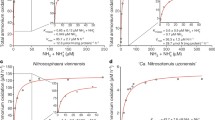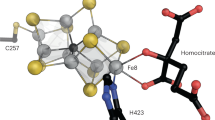Abstract
Incubation of whole cells of the nitrifying bacterium Nitrosomonas europaea with ethylene led to the formation of ethylene oxide. Ethylene oxide production was prevented by inhibitors of ammonium ion oxidation, and showed properties implying that ethylene is a substrate for the ammonia oxidising enzyme, ammonia monooxygenase. Endogenous substrates, hydroxylamine, hydrazine and ammonium ions were compared as sources of reducing power in terms of rates and stoichiometries of ethylene oxidation. The highest rates of ethylene oxide formation (15 μmol h-1 mg protein-1) were obtained with hydrazine as donor. The data suggest that at high concentrations of ethylene the rate of oxidation is limited by the rate at which reducing power can be supplied to the monooxygenase, not by an intrinsic V max. Ethylene had an inhibitory effect on the rate of ammonium ion utilisation; an approximate K i of 80 μM was derived, but the results deviated from simple competitive behaviour. Measurement of relative rates of ethylene oxide formation and ammonium ion utilization led to a k cat/K m value for ethylene of 1.1 relative to NH +4 , or 0.04 relative to the true natural substrate, NH3. The effects of higher concentrations of ethylene oxide on oxygen uptake rates were also investigated. The results imply that ethylene oxide is also a substrate for the monooxygenase, but with a much lower affinity than ethylene.
Similar content being viewed by others
References
Cornish-Bowden A (1979) Fundamentals of enzyme kinetics. Butterworths, London, p 85
Dalton H (1977) Ammonia oxidation by the methane oxidising bacterium Methylococcus capsulatus strain Bath. Arch Microbiol 114:273–279
Dalton H, Golby J, Stirling DI (1977) Microbiological oxidation processes. UK Patent Specification No 27886 (1977); No 1603864 (1981)
Drozd JW (1980) Respiration in the ammonia-oxidizing chemoautotrophic bacteria. In: Knowles CJ (ed) Diversity of bacterial respiratory systems, vol 2. CRC Press, Boca Raton, Florida, pp 87–111
Higgins IJ, Best DJ, Hammond RC (1980) New findings in methaneutilizing bacteria highlight their importance in the biosphere and their commercial importance. Nature 286:561–564
Hooper AB, Terry KR (1973) Specific inhibitors of ammonia oxidation in Nitrosomonas. J Bacteriol 115:480–485
Hou CT, Patel RN, Laskin AI, Barnabe N (1980) Microbial oxidation of gaseous hydrocarbons: Oxidation of lower n-alkenes and n-alkanes by resting cell suspensions of various methylotrophic bacteria, and the effect of methane metabolites. FEMS Microbiol Lett 9:267–270
Hynes RK, Knowles R (1982) Effect of acetylene on autotrophic and heterotrophic nitrification. Can J Microbiol 28:334–340
Hyman MR, Wood PM (1983) Methane oxidation by Nitrosomonas europaea. Biochem J 212:31–37
Lowry OH, Rosebrough NJ, Farr AL, Randall RJ (1951) Protein measurement with the Folin phenol reagent. J Biol Chem 193:265–275
Nicholas DJD, Jones OTG (1960) Oxidation of hydroxylamine in cell free extracts of Nitrosomonas europaea. Nature 185:512–514
O'Neill JG, Wilkinson JF (1977) Oxidation of ammonia by methaneoxidizing bacteria and the effects of ammonia on methane oxidation. J Gen Microbiol 100:407–412
Suzuki I, Dular U, Kwok SC (1974) Ammonia or ammonium ion as substrate for oxidation by Nitrosomonas europaea cells and extracts. J Bacteriol 120:556–558
Truesdale GA, Downing AL (1954) Solubility of oxygen in water. Nature 173:1236
Washburn EW (ed) (1928) International critical tables, vol 3. McGraw-Hill, New York, p 260
Author information
Authors and Affiliations
Rights and permissions
About this article
Cite this article
Hyman, M.R., Wood, P.M. Ethylene oxidation by Nitrosomonas europaea . Arch Microbiol 137, 155–158 (1984). https://doi.org/10.1007/BF00414458
Received:
Accepted:
Issue Date:
DOI: https://doi.org/10.1007/BF00414458




